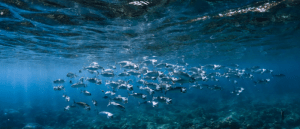
BioTechniques News
Aisha Al-Janabi

Using marine environmental DNA sampling, scientists identified more fish species than with conventional trawling techniques, but only if key implementation steps are followed.
Environmental DNA (eDNA) can detect DNA released by an organism into the environment, allowing scientists to identify individual species or reconstruct whole communities to monitor ecosystem changes from just a few liters of water. A collaborative study across museums, academic institutions and environmental consultants, led by Zack Gold (University of California, CA, USA), identified more fish species using eDNA compared to conventional ship-based trawl net samples. The results indicate eDNA is suitable for monitoring the effects of climate change on marine ecosystems.
Biodiversity is a key indicator of ecosystem health, so techniques to quantifiably measure biodiversity are needed. This is where eDNA comes in. eDNA is an application of gene sequencing that can be used to measure biodiversity. Gold explained, “There are genes that differ enough between species that they can be used as identification markers. Every organism sheds DNA by dropping skin cells or other materials, so we can take a cup of seawater, sequence the DNA in it, and use that to inventory organisms in the area,”.
The researchers wanted to find how best to use eDNA in the coastal ocean and determine if it can be applied to urban settings. To do so, they tested eDNA’s ability as a tool for biodiversity assessment in the Port of Los Angeles and Port of Long Beach (both CA, USA). These are among the largest port complexes in the world and a site of environmental interest, making them an ideal place to put eDNA to the test.
 Casting a wide net: no-fishing zones bring benefits to migratory species
Casting a wide net: no-fishing zones bring benefits to migratory species
A new study of no-fishing zones found a significant increase in migratory fish catch rates in surrounding areas.
The researchers collected samples of seawater for eDNA analysis alongside conventional ship-based trawl net sampling, collecting multiple samples at 7 different sites. This allowed them to compare eDNA to traditional techniques for biodiversity assessment.
eDNA was able to detect almost all of the 17 species detected in the trawls, as well as an additional 55 native fish species More sampling trips and a greater expense would have been required to detect those additional species using conventional sampling.
“We were happy to see eDNA validated alongside ‘conventional’ sampling, but we were really excited to see the extra information that came from the eDNA,” said Dean Pentcheff, (Natural History Museum of Los Angeles County; CA, USA), a co-author of the study.
The group found that eDNA samples from the different sites yielded statistically significant differences in species inventories. This showed that eDNA can measure variability across areas as small as a few hundred meters apart, indicating its suitability for application in urban settings.
Based on these results, the team created a set of recommendations for scientists and managers wanting to develop their own eDNA monitoring programs. This includes careful selection of genes for target species and cleaning up sequence data from samples before finding sequence matches.
A limitation of the technique is the need for a complete genetic reference library for each species to be able to identify them using eDNA. Therefore, the researchers suggest creating regional reference databases and sample archives to enable future analyses. As genetic data analysis techniques improve and reference libraries expand, future analyses could provide information on previously unidentifiable fish species, so they also recommend archiving eDNA samples for long term use.
“These samples of the environment are like time capsules that we’ll be able to exploit in the future,” said Adam Wall (Natural History Museum of Los Angeles County), a co-author of the study.
By applying these recommendations, better ecological interpretation and species detection can be achieved when using eDNA. This will be particularly useful for future studies that aim to track species’ range shifts due to climate change or to map endangered species habitats and invasive species fronts.
The post Finding Nemo: Using marine eDNA for biomonitoring appeared first on BioTechniques.
Full BioTechniques Article here
Powered by WPeMatico
